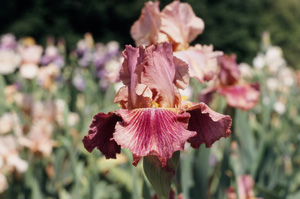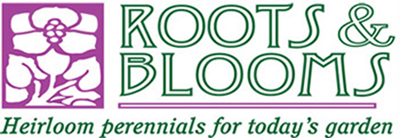
"Lockatell Seedling#20577"
(Northward Ho x Double Vision)
Plants increase from side shoots located on each side of a mature rhizome. Heavy concentrations of mature rhizomes are the primary reason for lack of yearly bloom. A general guide for dividing is every three to four years depending on variety. A staggered schedule of division will always insure a portion of the iris bed is in full bloom each growing season.
The optimal time to dig bearded irises is mid July. Divisions can be safely taken up to the beginning of September with excellent results. Old clumps can be safely excavated out of the ground by using a digging fork. Any clinging soil should be thoroughly removed and individual rhizomes separated by using a sharp knife or a pair of pruning shears. One half of each fan's existing foliage should be removed. Cuts can be made at forty-five degree angles towards the center of each fan. Large healthy rhizomes with multiple side buds should be selected for replanting and the remainder discarded.
Sterilization of divisions will protect any cutting wounds from soil bacteria attacks. Prepared rhizomes can be soaked in a 10 percent chlorine bleach solution (12.8 ounces per gallon). Mix two gallons of solution and submerge the entire rhizome for ten minutes. The bleach solution should be rinsed off treated divisions with clean tap water. The final step is to put divisions in a shaded spot to dry before replanting.
Bearded irises prefer well-drained soils. The incorporation of a coarse builder's sand into heavy clay soil will benefit these plants. Do not use any fine particle play sands in any soil modification efforts. A soil test before planting is highly recommended to determine pH levels and nutrition requirements. Bearded irises prefer a pH range of 6.5-7.0. Lime can be worked into the soil to alleviate low readings and sulfur for higher ones. Proper pH levels will always keep nutrients available for healthy plants. Another good practice at planting time is to amend soil with organic sources of phosphorous and potassium, such as Rock Phosphate and Green Sand. Low nitrogen complete fertilizers such as 5-10-10 can be applied each spring before foliage reaches mature height.
Divisions can be planted a minimum of twelve inches apart. A larger interval of eighteen inches gives a nice garden effect without the need of early division. New beds can be periodically watered during dry summers to help initiate new roots. Watering is not an issue with established beds. Mulching is not recommended.
Wet growing conditions can result in outbreaks of leaf spot fungus on foliage and bacterial soft rot on rhizomes. A foliar spray of Daconil® protects healthy iris foliage from leaf spot spores. Control lasts two weeks before reapplication is necessary. Periods of high humidity promote bacterial soft rot attacks on iris rhizomes. Affected areas should be thoroughly cleaned of any diseased tissue and wounds treated with an application of anti bacterial soap with Triclosan.
Good garden sanitation can help negate disease and insect issues. Dead and diseased foliage should be removed during late fall and winter months, A foliar spray of Merit (Imidachloprid) immediately following spring bloom protects plants from iris borers and minimizes aphid populations hiding at base of leaf fans. Infestations of salt marsh caterpillar and fall armyworm can result in significant feeding damage. Sevin is a good control measure for these insect pests. Crickets like to feed on exposed rhizome surfaces in mid summer. A light covering of soil over rhizomes eliminates this problem.
Good cultural practice leads to attractive bearded iris beds. Always keep these recommendations in mind, and your iris planting will be the envy of any neighborhood garden.
